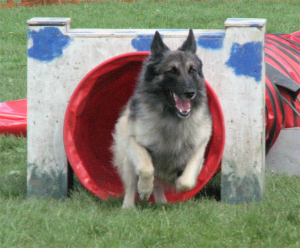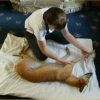 How often do we as dog owners find that one minute our dogs seem fine but the next they are ‘not quite right’. It is difficult to say when it happened, but over a few weeks or months you may notice small things such as your dog having difficulty getting into the car, up the stairs or onto their favourite chair. Maybe they don’t want to get out of bed, go for a walk or greet you how they used to. They may growl, whimper when touched or worse still, bite. If they are a competition dog their performance may be reduced.
How often do we as dog owners find that one minute our dogs seem fine but the next they are ‘not quite right’. It is difficult to say when it happened, but over a few weeks or months you may notice small things such as your dog having difficulty getting into the car, up the stairs or onto their favourite chair. Maybe they don’t want to get out of bed, go for a walk or greet you how they used to. They may growl, whimper when touched or worse still, bite. If they are a competition dog their performance may be reduced.
If any of this sounds familiar, it maybe that McTimoney Chiropractic is worth considering. Susan Sargeant is a Registered Chiropractor who uses the McTimoney method of chiropractic and undertook a further post graduate diploma in animal manipulation. She now uses the techniques on animals as well as humans.
Susan believes that dogs like people, can suffer from musculo-skeletal problems affecting not only the back but the neck, pelvis and limbs as well. Very often the dog’s only way of communicating these problems to us is to display a change in personality, character or performance as indicated in the examples above.
McTimoney Chiropractic is a non invasive gentle form of treatment where the practitioners use their hands to perform a very fast and precise ‘adjustment’ to any misaligned bone releasing them and in addition reducing pain and inflammation and increasing range of movement. It concentrates on the whole body to eliminate the cause of problems not just the symptoms.
Misalignments can cause various symptoms and the dog will often subtly change his gait to compensate for the problem. The joints involved can become stiff and lack their normal range of motion. Ligaments will be put under extra strain, muscles will have reduced elasticity and be more prone to injury. In addition nerves can become impinged causing muscle wasting (atrophy), weakness and in some cases, paralysis. Swelling and inflammation may be evident. If the nerve supply to various organs and glands is affected, symptoms of disease can often be noticed. All this will have a knock on effect throughout the body leading to further misalignments.
The causes of misalignments in dogs are numerous and include:
- Trauma such as accidents, falls, road traffic accidents.
- Repetitive activities that build up to cause a series of micro-traumas over a period of time i.e. jumping on and off the sofa, in and out of the car.
- Competitions – Greyhound / Whippet racing (bends – one direction, builds up muscle imbalance and crookedness throughout spine and pelvis.) Agility (sudden stopping /starting / tight turns, contact obstacles, weaves). Obedience – training involves the dog walking to the left of the owner so that he is craning his neck to the right.
- Breed weakness – different breeds have different flexibility and different areas of weakness e.g.
Dachshund – disc problems, German Shepherds – Hip dysplasia.
- Stud & breeding duties.
- Dental problems.
- Lameness can cause the dog to compensate which can develop into secondary back problems.
Prevention is better than cure and Susan recommends that every dog is checked at least every 6 months to avoid injury, improve performance and increase well being. She also stresses that Chiropractic does not surpass veterinary diagnosis. Current legislation means that veterinary approval must be obtained prior to treatment of any animal. If you wish to know more about chiropractic or how it could benefit your dog, Susan can be contacted on 0208 405 1268/ 07957 509594.










